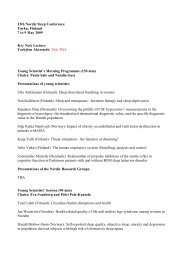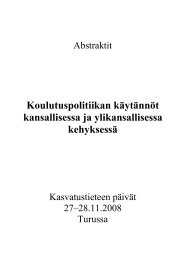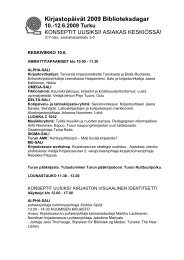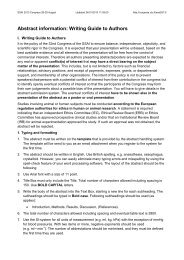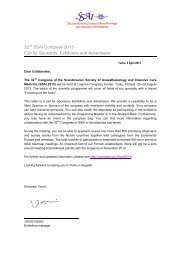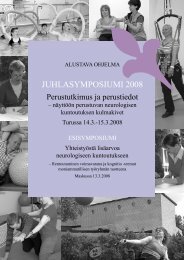Affirmative Politics in Italy DI TOMMASO, Maria Laura
Affirmative Politics in Italy DI TOMMASO, Maria Laura
Affirmative Politics in Italy DI TOMMASO, Maria Laura
You also want an ePaper? Increase the reach of your titles
YUMPU automatically turns print PDFs into web optimized ePapers that Google loves.
VOTING AND GENDER. AFFIRMATIVE POLITICS IN ITALYGenny Bonomi, Giorgio Brosio and <strong>Maria</strong> <strong>Laura</strong> Di Tommaso 1Paper prepared for presentation at the EPCS2006: European Public Choice Society 2006 AnnualMeet<strong>in</strong>g, Turku, F<strong>in</strong>land, 20-23 April 2006.1 Dipartimento di Economia, University of Tor<strong>in</strong>o, <strong>Italy</strong>.Acknowledgements: The authors would like to thank for helpful comments and suggestions: Leif Andreassen, Ugo Colomb<strong>in</strong>o,Marila Guadagn<strong>in</strong>i, Federico Revelli, Alessandra Ventur<strong>in</strong>i.The research was carried out as part of a National Research Project: “ Analys<strong>in</strong>g failures of democratic <strong>in</strong>stitutions and policies tocorrect them: a public choice approach” funded by Italian M<strong>in</strong>istry for Education, University and Research, Research Project cof<strong>in</strong>ancedby MURST 40%, for the years 2004 and 2005.1
IntroductionDiscrim<strong>in</strong>ation aga<strong>in</strong>st women <strong>in</strong> politics has a long history. In most countries universal suffrage wasextended to women only decades after it was <strong>in</strong>troduced for men. Although the right to be elected wasgranted to women at the same time of the right to elect, de facto the share of elected positions held bywomen is still very small, if not marg<strong>in</strong>al even <strong>in</strong> fully fledged democratic systems (Dahlerup, 2002;Matland, 2002, and more <strong>in</strong> general International Idea). To <strong>in</strong>crease this share many countries,<strong>in</strong>clud<strong>in</strong>g <strong>Italy</strong> have <strong>in</strong> recent times <strong>in</strong>troduced quotas for women <strong>in</strong> their electoral rules. Althoughthere is a huge descriptive literature on quota systems, analytical studies are still very few. This paper isa contribution to this t<strong>in</strong>y literature. It exam<strong>in</strong>es, us<strong>in</strong>g a model of voter utility maximization, how the,still occasional, <strong>in</strong>troduction of quota systems for women <strong>in</strong> <strong>Italy</strong> has impacted on the number of votesreceived by women and, through this, on their chances of be<strong>in</strong>g elected.The paper is divided <strong>in</strong>to three ma<strong>in</strong> sections plus the conclusions.The first section provides an illustration of quota systems and of their likely impact on the probabilitiesof women to be elected <strong>in</strong> different electoral systems. The scattered experience of electoral quotas <strong>in</strong><strong>Italy</strong> is also illustrated. The second section presents a voter random utility model that is built to analysethe impact of quotas and of other factors on the gender choice of voters. The model is then tested withreference to the elections of regional councils of 1995 and 2000 <strong>in</strong> section three.1. Quota systems and their properties1.1. Varieties of quotas systems.Gender quotas <strong>in</strong> elections can have a dist<strong>in</strong>ct orig<strong>in</strong>. They can be <strong>in</strong>troduced by law (constitutional orord<strong>in</strong>ary), or through discretionary decisions by political parties. Sweden provides an outstand<strong>in</strong>gexample of the latter system: the ma<strong>in</strong> parties reserve at least 50 per cent of their lists to femalecandidates. Legally enforced quotas and discretionary quotas by parties are not mutually exclusive. Theusual pattern is that parties build on the quotas <strong>in</strong>troduced by law, by expand<strong>in</strong>g them.Quota systems differ fundamentally <strong>in</strong> their object. In fact, we can dist<strong>in</strong>guish between systems basedon reservation of seats <strong>in</strong> legislative assemblies and systems based on reservation of candidacies. Theyresults are obviously different.2
Reservation of seats ensures that a given (ex ante determ<strong>in</strong>ed) number of women will be elected. In afirst past the post system, a given number of electoral districts will be reserved only to candidates of thesame gender. With proportional representation each district will elect the same (also ex antedeterm<strong>in</strong>ed) proportion of seats by gender. In both cases, voters can decide, by choos<strong>in</strong>g the party,whom will be elected, but they have no possibility of impact<strong>in</strong>g on the distribution by gender of electedpersons. They cannot <strong>in</strong>crease, or decrease, the share of women, or male, elected. An example of thissystem has been implemented <strong>in</strong> the Indian municipality elections. (Chattopadhyay, Raghabendra andDuflo 2004).A slightly weaker version of the reservation of seats system is provided by closed list systems, if the lawprescribes gender quotas and the order <strong>in</strong> which candidates are presented <strong>in</strong> the lists. The electoral lawfor the French Senate provides an illustration. It prescribes that each list has to <strong>in</strong>clude alternatively oneman and one woman. (It could be the reverse, of course).With closed systems voters cannot choose among candidates; they can only choose the list. Closedsystems can ensure almost equal representation of genders, depend<strong>in</strong>g on the gender that gets the firstplace on the list 2 . Closed list systems, however, are not immune to strategic behaviour by those parties,which are aga<strong>in</strong>st the election of women, as the French experience illustrates. Many parties decided tosplit themselves, present<strong>in</strong>g <strong>in</strong> the same electoral district dist<strong>in</strong>ct lists with only one, male, candidateeach, thus underm<strong>in</strong><strong>in</strong>g completely the system of quotas. (See, Maniquet, Frechette and Morelli, 2005).Reservation of candidacies is the mildest form of affirmative electoral action. It is used <strong>in</strong> a numberof countries, <strong>in</strong>clud<strong>in</strong>g <strong>Italy</strong>. It ensures a given m<strong>in</strong>imum number of candidacies by gender, but it doesnot ensure that this m<strong>in</strong>imum number will be elected. It is the voters who will decide the distributionby gender. In other words, reservation of candidacies comb<strong>in</strong>es some compulsion upon parties with<strong>in</strong>centives for voters. Compulsion derives from the limits imposed on the choice of candidates.Incentives for voters come from the wider choice offered <strong>in</strong> terms of gender of candidates.Reservation of candidacies aims at solv<strong>in</strong>g (or alleviat<strong>in</strong>g) two dist<strong>in</strong>ct problems. Barriers for women toentry <strong>in</strong>to the electoral arena are the first problem, s<strong>in</strong>ce parties are traditionally dom<strong>in</strong>ated by males. Ifthere is collusion between parties about the exclusion of female’s candidates, reservation of seats is theonly way to reduce barriers. 3 The second problem is a direct consequence of the first. S<strong>in</strong>ce there arefew women on election lists, voters have a restricted choice that turns to the disadvantage of women2 If lists get an odd number of seats the gender that occupies the first place on the list will get a majority of seats. Thehighest possible majority for the advantaged gender will be of two/thirds.3 One could also imag<strong>in</strong>e that <strong>in</strong>cumbent women are aga<strong>in</strong>st quotas s<strong>in</strong>ce their reduce their chances to be re-elected3
politicians. The rationale of quotas of candidacies is that there is no anti-female bias of voters. Ratherelectoral fortunes of women are constra<strong>in</strong>ed by the limited range of choice given to voters. This is, <strong>in</strong>fact, the ma<strong>in</strong> hypothesis that is tested <strong>in</strong> this paper.1.2. Quotas and electoral systemsElectoral systems are also impact<strong>in</strong>g differently on the electoral fortunes of genders. More precisely,quotas of candidacies have a different effectiveness <strong>in</strong> dist<strong>in</strong>ct electoral systems (FPTP). For the sake ofbrevity, we restrict the illustration to a typical majoritarian system - namely, the first-past-the postsystem - and a pure proportional system of representation (PR).In FPTP, once women are <strong>in</strong>serted <strong>in</strong>to the list, they have higher chances to be elected than <strong>in</strong> a PRsystem. This is because voter choices are more restricted. Voters with a gender bias, who happen to ahave a female candidate <strong>in</strong> their district, have to change party if they want to express their bias. In a PRsystem voters with an anti female bias do not need to change party to express it. They have just toselect male candidates. Moreover, <strong>in</strong> PR systems the chances of women to be elected could beimperilled by an <strong>in</strong>creased dispersion of votes brought up by the wider choice of female candidates. Inother words, quotas can ensure <strong>in</strong>creases <strong>in</strong> the number of votes to women, but can not necessarily<strong>in</strong>crease the chances of women to be elected. Dispersion is expected to <strong>in</strong>crease with the <strong>in</strong>crease <strong>in</strong> thesize of districts, while by def<strong>in</strong>ition it does not take place <strong>in</strong> s<strong>in</strong>gle candidate districts; that is, <strong>in</strong> FPTPsystems.Both electoral systems are not proof to strategic behaviour of political parties. In a FPTP system partiescan dilute, or even elim<strong>in</strong>ate, the impact of quotas by present<strong>in</strong>g women <strong>in</strong> districts where the chancesof w<strong>in</strong>n<strong>in</strong>g are low, and reserv<strong>in</strong>g strong districts (where the chances are high) to male candidates. Thisis exactly what happened <strong>in</strong> France <strong>in</strong> the 2002 elections of the lower house, accord<strong>in</strong>g to Maniquet,Frechette and Morelli (2005). The argument of these authors is even stronger. They ma<strong>in</strong>ta<strong>in</strong> that the<strong>in</strong>troduction of a quota (vary<strong>in</strong>g between 48 and 52 per cent) of female candidates was welcomed by(male) party leaders because, given the presumption of a widespread anti female bias of French voters,quotas <strong>in</strong>creased the chances of male candidates to run aga<strong>in</strong>st a, weaker, female candidate. In PRsystems party leadership could assign female candidates to the lowest part of the list, thus decreas<strong>in</strong>gjo<strong>in</strong>tly their visibility and their chances of be<strong>in</strong>g elected. To fight this latter impediment to the electoralfortunes of women, some national regulations impose also the alternance of candidates of dist<strong>in</strong>ctgenders on election lists. Aga<strong>in</strong>, we will try to test <strong>in</strong> this paper the impact of the position on lists onthe chances to be voted.4
1.3. <strong>Affirmative</strong> electoral policies <strong>in</strong> <strong>Italy</strong><strong>Italy</strong> has a very short and scattered experience with gender quotas. Quotas have been used once (1994)for the Lower House <strong>in</strong> the national parliament; once (1999) for the European parliament; once (1995)for municipal and prov<strong>in</strong>cial elections, and twice (1995 and 2005) for regional elections (but only <strong>in</strong> afew regions <strong>in</strong> 2005).Quota systems for the election of municipal and prov<strong>in</strong>cial councils and for the Lower House impliedthat a s<strong>in</strong>gle gender could not be assigned with more than 75 percent of candidates. However, for theLower House the quota only applied to the 25 per cent of the seats that are assigned accord<strong>in</strong>g to theproportional representation system. In other words, quotas could only ensure to women a maximumshare of one sixteen of total seats (25 per cent out of 25 per cent). The share of candidacies reserved towomen <strong>in</strong> regional councils was slightly higher: 30 per cent 4 .In 1995 the Constitutional Court declared quotas as unconstitutional, stat<strong>in</strong>g that “Accord<strong>in</strong>g to the Court,the fundamental right of equal access to elective offices, as established by Art. 3 and 51 of theConstitution cannot be subjected to special treatment on the basis of sex.”(Guadagn<strong>in</strong>i, 1998, page 99)The decision of the Constitutional Court required the <strong>in</strong>troduction of constitutional amendments toallow the <strong>in</strong>sertion of gender quotas for elections.In 2003 a constitutional reform <strong>in</strong>cluded two separate provisions related to gender equality <strong>in</strong> politicalrepresentation. The first provision refers to the European, the national parliaments and the municipaland prov<strong>in</strong>cial councils. Article 51 states that “citizens of one or the other sex are eligible for publicoffice and for elective positions under equal conditions, accord<strong>in</strong>g to the rules established by law. Tothis end, the republic adopts specific measures <strong>in</strong> order to promote equal chances for men and women”.The second provision refers to Regions, which have autonomous powers concern<strong>in</strong>g the election oftheir councils. Article 117 states that “Regional laws have to remove all obstacles which prevent thefull equality of men and women <strong>in</strong> social, cultural, and economic life, and promote equal access to menand women to elective offices”.A quota of 30 per cent of seat was thereafter <strong>in</strong>troduced for the European election of 1999 5 .Furthermore, a system of reduction of refund of electoral expenses for those parties that had not4 The law 277 of August 4, 1993 concern<strong>in</strong>g the election of the Lower House stated that for the share of seatsreserved to the proportional system (25%) each list must be formed by candidates of both sexes listed <strong>in</strong>alternative order. The law of February 23, 1995 for the elections <strong>in</strong> ord<strong>in</strong>ary statute regions stated that <strong>in</strong> eachregional and prov<strong>in</strong>cial list no one of the two sexes has to be represented by more than two thirds of thecandidates.5 Article 3 of Law 90 of April 8, 2004 on equal opportunities.5
complied with their obligation concern<strong>in</strong>g the shares was also <strong>in</strong>troduced. F<strong>in</strong>ally, parties could notpresent electoral lists with more than one candidate if both genders were not represented.The constitutional reform <strong>in</strong>duced a number of regions to <strong>in</strong>troduce quotas (Lazio, Puglia, Toscana,Abruzzo, Calabria and Valle d’Aosta) for the election of 2005.Elections to regional councils are the most suited for applied analysis on voter behavior concern<strong>in</strong>ggender choices. In fact, the model we build <strong>in</strong> this paper will be tested with reference to them. This isbecause the number of electoral districts and of seats assigned <strong>in</strong> regional councils is much higher thanfor the national parliament. However, regional elections present a problem for the test<strong>in</strong>g the impact ofquotas on the number of elected female candidates. This is because of the rather complex electoralsystem for regions that mixes a majoritarian and a proportional component. The total number ofwomen elected may depend, not on the number of the votes they receive, but rather from the electoralfortunes of the parties where they are enlisted. More specifically, the party coalition that gets theplurality of seats will receive a “majority premium”; that is, an <strong>in</strong>crease <strong>in</strong> the number of seats allocatedto it that exceeds the number determ<strong>in</strong>ed on the basis of the votes received.1.4. Effectiveness of Italian quotasThe percentage of women <strong>in</strong> the Italian Parliament is very low. <strong>Italy</strong> is only 78 <strong>in</strong> the <strong>in</strong>ternationalrank<strong>in</strong>g of countries accord<strong>in</strong>g to the number of seats <strong>in</strong> the national parliament assigned to women.However, as reported <strong>in</strong> table 1 that follows, quotas seems to have a slightly appreciable impact, s<strong>in</strong>cethe share of seats assigned to women <strong>in</strong> 1994, where the quota system was work<strong>in</strong>g, is higher than thatof the follow<strong>in</strong>g elections, when no quotas applied.Table 1. Share of seats <strong>in</strong> the Italian Lower House assigned to women, 1994 -2001.Year Upper House Lower House1994 8,6% with quotas 15,1%1996 no quotas 8% 11,1%2001 no quotas 8.1% 11,5%Source: for 1994 Guadagn<strong>in</strong>i (2003); for 1996/2001 Women <strong>in</strong> national parliaments – www.ipu.org6
A similar pattern shows up for the elections to the European Parliament. The percentage of womenelected <strong>in</strong>creased from 11,5% <strong>in</strong> 1999 to 19, and 23% <strong>in</strong> the year 2004, when the quota system was<strong>in</strong>troduced.Table 2. Share of seats assigned to women <strong>in</strong> the elections for the European Parliament, 1999and 2004EUROPE1999ITALY1999(without quotas)EUROPE2004Total seats 626 87 732 78Seats won bywomen195 10 221 15ITALY2004(with quotas)% 31,1% 11,50% 30.19% 19.23%Source: <strong>Italy</strong>: Presidenza del consiglio dei m<strong>in</strong>istri – M<strong>in</strong>istero Pari opportunità - www.pariopportunita.gov.itRegional councils are not an exception, as can be seen <strong>in</strong> table 3 that follows. In this case we have threeelectoral rounds to observe (although the third one is <strong>in</strong>complete, as mentioned before). Quotas seemto impact on the electoral fortunes of women.Table 3. Share of seats assigned to women <strong>in</strong> regional elections. 1995, 2000 and 2005Regions 1995 2000 2005Abruzzo 10.00%* 2.33% 17.07%*Basilicata 6.67%* 10.00% 10.71%Calabria 9.52%* 2.33% 4.08%Campania 6.67%* 5.00% 10.17%Emilia-Romagna 18.00%* 14.00% 10.20%Lazio 17.46%* 12.24% 17.91%*Liguria 15.56%* 7.50% 10.26%Lombardia 14.44%* 11.25% 15.19%Marche 12.50%* 12.50% 15.38%Molise 13.33%* 3.33%Piemonte 16.67%* 11.67% 16.13%7
Puglia 12.70%* 0.00% 2.86%*Toscana 16.00%* 12.00% 24.62%*Umbria 16.67%* 13.33% 13.79%Veneto 7.81%* 15.00% 10.17%Totale 13.80% 9.85% 12.93%* elections with quotaSource: for 1995 and 2000 Presidenza del consiglio dei m<strong>in</strong>istri – M<strong>in</strong>istero Pari opportunità -www.pariopportunita.gov.it; for 2005 M<strong>in</strong>istero degli <strong>in</strong>terni – Anagrafe Amm<strong>in</strong>istrazioni Locali, 2005 Toscana ePuglia siti collegio regionale.2. A Random Utility Model for the voter.We start with the assumption that voters are rational <strong>in</strong> the sense that they vote to maximize theirperceived utility. However, there are many errors <strong>in</strong> this maximization because of imperfect perceptionsand optimization, as well as the errors made by the analyst to measure exactly all the relevant variables.In this k<strong>in</strong>d of sett<strong>in</strong>g, McFadden (1974), (follow<strong>in</strong>g Thurstone 1927), assumed that utility is a randomfunction. We follow McFadden (1974) and, <strong>in</strong> the context of an election process, we assume a randomutility model for the voter.Suppose that the <strong>in</strong>dividual faces a number of choices equal to J where we def<strong>in</strong>e j=1, 2, 3, ……., J.We can def<strong>in</strong>e an underly<strong>in</strong>g latent variable Y *njwhich denote the utility of voter n associated withchoice j.The observed Ynjare def<strong>in</strong>ed asYYnjnj= 1 if Y*nj= Max(Y= 0 otherwise*n1, Y*n2, Y*n3,.......... Y*nJ)(1)More specifically, the utility that the nth voter will make choice j is given byYY*njnj= Vnj(Xnj,Zn) + εnj= 0 otherwise(2)Where V nj is the determ<strong>in</strong>istic part of the utility function and Z n are <strong>in</strong>dividual-specific variables (voterspecificvariables) and εnjis a residual that captures both the unobserved variations <strong>in</strong> the attributes ofthe choices, the errors <strong>in</strong> the perception of the <strong>in</strong>dividual and what the analyst cannot observe. X nj isthe vector of values of the attributes of the jth choice as perceived by the nth <strong>in</strong>dividual. If the residualare <strong>in</strong>dependently and identically distributed with the type I extreme value distribution, whosecumulative distribution function is−εF(ε j< ε ) = exp( −e)(3)8
it has been demonstrated (Maddala 1983) that the probability of <strong>in</strong>dividual n to make choice j is givenby the follow<strong>in</strong>g:Pnjje= Pr ob(Ynj= 1) =J(4)Vke∑Vk = 1In our model, the determ<strong>in</strong>istic part of the utility function, Vnj(Xnj,Zn), will be def<strong>in</strong>ed as follows:Vnj= β X + α Z(5)njjnWhere Z n is a p x 1 vector of <strong>in</strong>dividual-specific variables and X nj is q x 1 vector of values of theattributes of the jth choice as perceived by the nth <strong>in</strong>dividual. α j is a 1 x p vector of parameters; β is a 1x q vector of parameters. Note that the number of β’s does not depend on the number of choices.While the number of α j ’s is equal to J-1.Then, the probability that voter n makes choice j is the follow<strong>in</strong>g:Pnje= Pr ob(Ynj= 1) =Je∑k = 1βXnjβX+ α Znkjn+ α Zkn(6)This framework will allow us to estimate the probability that voter n will choose candidate of type j andwith the estimated parameters, α j ‘s and β’s, it is possible to simulate how the probability of vot<strong>in</strong>gcandidate of type j changes when the <strong>in</strong>dependent variables change. Similar types of model have beenestimated by McFadden (1974).3. The empirical specification3.1 Sample and sources of dataThis paper utilizes data on candidates for four Italian regions <strong>in</strong> the 1995 and 2000 elections. Weselected the three Italian regions that had elections <strong>in</strong> 2005 with a new regional electoral law re<strong>in</strong>troduc<strong>in</strong>ggender quotas (Toscana, Puglia, Lazio) and a region that did not re-<strong>in</strong>troduce gender quotas<strong>in</strong> 2005 as a basel<strong>in</strong>e (Piemonte). The data used <strong>in</strong> this study are based on the <strong>in</strong>formation collectedfrom the web site of the Italian M<strong>in</strong>istry of Home Office (M<strong>in</strong>istero degli Interni) or directly obta<strong>in</strong>ed fromthe Central Office for Electoral Services (Direzione Centrale Servizi Elettorali) of the same M<strong>in</strong>istry. Thetotal number of candidates is equal to 5239 correspond<strong>in</strong>g to all the candidates participat<strong>in</strong>g to theproportional share of the elections <strong>in</strong> the four regions for the two years (1995, 2000). 6 The unit of6 The analysis of 2005 election is carried out separately to take <strong>in</strong>to account differences among the new regional laws <strong>in</strong>terms of gender quotas and electoral systems proposed and it is not part of the present paper.9
observation is the candidate. Tables A1 and A2 <strong>in</strong> the appendix list the variables used <strong>in</strong> the empiricalspecification and report some descriptive statistics of the variables used.The variables used <strong>in</strong> the estimation are the follow<strong>in</strong>g: region, electoral district, year of election, genderof the candidate, age of the candidate, position of the candidate <strong>in</strong> the list, share of votes obta<strong>in</strong>ed bythe candidate, be<strong>in</strong>g an <strong>in</strong>cumbent, percentage of women on the list, share of votes obta<strong>in</strong>ed by the list,party position on liberal policies.The variable <strong>in</strong>cumbent has been constructed us<strong>in</strong>g the database of the adm<strong>in</strong>istrators of local governments(Anagrafe degli Amm<strong>in</strong>istratori degli Enti Locali) of the M<strong>in</strong>istry. It corresponds to the presence <strong>in</strong> theyear before the elections of the candidates <strong>in</strong> the councils and government bodies of the region,prov<strong>in</strong>ces and major cities. There is a broad literature on <strong>in</strong>cumbency advantage and more <strong>in</strong> particularon the effect of this factor on women’s election. The idea is that women are underrepresented <strong>in</strong>legislature because the vast majority of <strong>in</strong>cumbents are men and <strong>in</strong>cumbents have an advantage ma<strong>in</strong>lydue to the visibility that a public office can give them. The result can be a perpetuation of malerepresentation.The variable related to the party position on liberal policies is taken from an expert survey, carried outby Benoit and Laver (2005), aimed to assign party positions on a range of policy dimensions <strong>in</strong> 47countries. Different dimensions were available among which we chose the dimension labelled “Social”.This dimension is def<strong>in</strong>ed as been <strong>in</strong> favour of liberal policies on matters such as abortion,homosexuality and euthanasia. This variable is used to differentiate between parties on the base of theirposition <strong>in</strong> the political space.Table A2 <strong>in</strong> Appedix A reports some descriptive statistics of the variables.Table 4 reports the number of female candidates for the proportional component of the regionalelections <strong>in</strong> the two years. The percentage of female candidates largely decreased <strong>in</strong> all the four regions.Puglia is the region that registered the higher variation.The percentage of women elected <strong>in</strong> the two years for the proportional component of the regionalcouncil decreased <strong>in</strong> Toscana, Lazio e Puglia. It only <strong>in</strong>creased <strong>in</strong> Piemonte. (see table A3 <strong>in</strong> AppendixA).Tab. 4 Percentage of women candidate <strong>in</strong> our sampleRegions 1995 2000Piemonte 36.97% 23.73%Toscana 36.27% 23.57%Lazio 35.37% 17.96%Puglia 34.95% 13.94%Total 35,9% 19,4%10
Table 6: Observed and predicted probabilitiesNumber ofobservations Predicted ObservedJ1:man top of the list <strong>in</strong>cumbent 191 42.09% 41.96%J2: man top of the list non-<strong>in</strong>cumbent 451 37.75% 41.62%J3: Man bottom of the list <strong>in</strong>cumbent 178 39.56% 41.98%J4: Man bottom of the list non-<strong>in</strong>cumbent 679 45.38% 41.42%J5 Women top of the list <strong>in</strong>cumbent 28 29.57% 27.62%J6 Women top of the list non-<strong>in</strong>cumbent 220 12.38% 14.24%J7: Women bottom of the list <strong>in</strong>cumbent 29 27.16% 24.97%J8: Women bottom of the list non-<strong>in</strong>cumbent 472 14.71% 15.23%Men 1499 41.97% 41.62%Women 749 15.06% 15.78%In order to comment on the estimated parameters, we simulate an <strong>in</strong>crease <strong>in</strong> the percentage of women<strong>in</strong> each list. We simulate the application of a quota of 35%, 45% and 55% of women for each list. Themicro-simulation consists of apply<strong>in</strong>g the estimated parameters to equation (6), and calculat<strong>in</strong>g for eachvoter the estimated probability after the change. Table 7 reports the average simulated probability ofvot<strong>in</strong>g for candidate of type j. Ceteris paribus, the probabilities of a female candidate to be voted <strong>in</strong>creaseif the number of women <strong>in</strong> the list <strong>in</strong>creases. This implies that, given a constant length of the list, thevotes are re-distributed to female candidates.These <strong>in</strong>creases are the largest for non-<strong>in</strong>cumbent women and they <strong>in</strong>crease with the size of the quotas.One possible explanation for the large <strong>in</strong>crease <strong>in</strong> the probability that the voter chooses a non<strong>in</strong>cumbentwoman is that non-<strong>in</strong>cumbent candidates would have not be<strong>in</strong>g <strong>in</strong>cluded <strong>in</strong> the list if thequota were not implemented and therefore they could not be voted for. It seems like that voters wouldlike to vote for non-<strong>in</strong>cumbent female candidate but, <strong>in</strong> the absence of quotas, they can’t. In theabsence of quotas, their preferences cannot be expressed.The estimated parameters describe the correlations <strong>in</strong> our data. Our simulations are based on theassumption that these parameters only reflect a causal connection between votes for women andnumber of women on the list. In reality they probably also reflect a common factor <strong>in</strong>fluenc<strong>in</strong>g both (<strong>in</strong>some districts or regions there could be a bias aga<strong>in</strong>st women that affects both the number of women<strong>in</strong> the list and the way <strong>in</strong> which voters vote). Hopefully, any common factor is controlled for by the<strong>in</strong>clusion of the other variables especially variables def<strong>in</strong><strong>in</strong>g the party <strong>in</strong> each district (length of theparty). In addition, <strong>in</strong> half the sample the number of women <strong>in</strong> the list can be considered exogenousdue to the presence of quotas <strong>in</strong> 1995.Table 8 reports simulated <strong>in</strong>creases <strong>in</strong> the length of each list. The simulations show that an <strong>in</strong>crease <strong>in</strong>the length of the list <strong>in</strong>creases the probabilities for non-<strong>in</strong>cumbent to be voted (the effect is larger fornon-<strong>in</strong>cumbent women than for non-<strong>in</strong>cumbent men) and decreases the probability of <strong>in</strong>cumbent to bevoted (the effect is larger for <strong>in</strong>cumbent women respect to <strong>in</strong>cumbent men). This result confirms the13
presence of a dispersion effect: the shorter the list the more the votes concentrate on <strong>in</strong>cumbentcandidates.Table 9 reports simulated decreases <strong>in</strong> the <strong>in</strong>dex report<strong>in</strong>g the position of parties <strong>in</strong> favor of liberalpolicies. The <strong>in</strong>dex ranks from 1 to 20, where 1 <strong>in</strong>dicates that the party is very much <strong>in</strong> favor of liberalpolicies (abortion, homosexuality and euthanasia) and 20 that the party is aga<strong>in</strong>st them. We observe thatthe probabilities of voters to vote a female candidate <strong>in</strong>creases with the party becom<strong>in</strong>g more liberal.Table 7: Average of the estimated probabilities before and after an <strong>in</strong>crease <strong>in</strong> the % of women<strong>in</strong> each list.Simulation of a35% quota(35% quotas –predicted)Simulation of a45% quota(45% quotas –35% quotas)Simulation of a55% quota(55% quotas –45% quotas)PredictedprobablitiesJ1:man top of the list <strong>in</strong>cumbent 42.09% 40.27%(-1.82) 38.03%(-2.24) 35.08% (-2.95)J2: man top of the list non<strong>in</strong>cumbent37.75% 39.58%(-1.83) 39.74% (-.16) 39.23% (-.51)J3: Man bottom of the list<strong>in</strong>cumbent 39.56% 38.58% (-.98) 37.52% (-1.06) 35.54% (-1.98)J4: Man bottom of the list non<strong>in</strong>cumbent45.38% 43.30% (-2.08) 41.33% (-1.97) 38.40% (-2.93)J5 Women top of the list<strong>in</strong>cumbent 29.57% 29.99% (+.42) 30.27% (+.28) 30.29% (+.02)J6 Women top of the list non<strong>in</strong>cumbent12.38% 13.73% (+1.35) 16.38% (+2.65) 19.91% (+3.53)J7: Women bottom of the list<strong>in</strong>cumbent 27.16% 28.10% (+.94) 29.55%(+1.45) 32.46% (+2.91)J8: Women bottom of the list non<strong>in</strong>cumbent14.71% 16.34% (+1.61) 18.99%(+2.65) 23.81%(+4.82)Men 41.97% 41.24% (-0.73%) 39.98%(-1.26%) 37.89%(-2.09)Women 15.06% 16.54%(+1.48%) 19.06%(+2.52%) 23.24%(+4.18%)14
Table 8: Average of the estimated probabilities before and after an <strong>in</strong>crease <strong>in</strong> the length of thelist <strong>in</strong> the districts.20%Increaselenght ofthe list <strong>in</strong>thedistrict40%Increaselenght ofthe list <strong>in</strong>thedistrict60%Increaselenght ofthe list <strong>in</strong>thedistrictPredictedJ1:man top of the list <strong>in</strong>cumbent 42.09% 41.51% 40.93% 40.34%J2: man top of the list non<strong>in</strong>cumbent37.75% 37.81% 37.86% 37.90%J3: Man bottom of the list<strong>in</strong>cumbent 39.56% 39.10% 38.64% 38.20%J4: Man bottom of the list non<strong>in</strong>cumbent45.38% 45.57% 45.76% 45.94%J5 Women top of the list<strong>in</strong>cumbent 29.57% 27.09% 25.04% 23.31%J6 Women top of the list non<strong>in</strong>cumbent12.38% 12.68% 12.99% 13.31%J7: Women bottom of the list<strong>in</strong>cumbent 27.16% 26.68% 26.22% 25.79%J8: Women bottom of the listnon-<strong>in</strong>cumbent 14.71% 14.81% 14.91% 15.01%Men 41.97% 41.95% 41.92% 41.89%Women 15.06% 15.10% 15.16% 15.24%Table 9: Average of the estimated probabilities before and after a decrease <strong>in</strong> the position ofthe party on liberal policies (a decrease <strong>in</strong>dicate that parties become more liberal).Predicted20%decrease40%decrease60%decreaseJ1:man top of the list <strong>in</strong>cumbent 42.09% 41.45% 40.79% 40.11%J2: man top of the list non<strong>in</strong>cumbent37.75% 37.90% 38.03% 38.13%J3: Man bottom of the list<strong>in</strong>cumbent 39.56% 40.35% 41.14% 41.92%J4: Man bottom of the list non<strong>in</strong>cumbent45.38% 44.77% 44.16% 43.53%J5 Women top of the list<strong>in</strong>cumbent 29.57% 33.12% 36.86% 40.70%J6 Women top of the list non<strong>in</strong>cumbent12.38% 13.02% 13.71% 14.44%J7: Women bottom of the list<strong>in</strong>cumbent 27.16% 25.15% 23.19% 21.31%J8: Women bottom of the listnon-<strong>in</strong>cumbent 14.71% 15.02% 15.33% 15.65%Men 41.97% 41.75% 41.52% 41.28%Women 15.06% 15.50% 15.96% 16.45%ConclusionsIn this paper, we have started an exploration of the effectiveness of affirmative electoral action <strong>in</strong> <strong>Italy</strong>.Traditionally, but not unusually, the country has a small number of female elected politicians. To<strong>in</strong>crease this number, quotas, based on a m<strong>in</strong>imum share of candidacies reserved to either gender, have15
een <strong>in</strong>troduced for elections at all levels of government. Their <strong>in</strong>troduction has been delayed becauseof, among other th<strong>in</strong>gs, an <strong>in</strong>itial verdict by the Supreme Court that quotas are unconstitutional. Quotasare small – they do not exceed 30 percent of total candidates – and apply only to seats that are allocatedon the basis of the proportional system <strong>in</strong> local, regional, and national elections.In general, the <strong>in</strong>troduction of quotas has brought an <strong>in</strong>crease <strong>in</strong> the share of elected women, whichrema<strong>in</strong>s t<strong>in</strong>y.The paper has explored, with the help of a voter random utility maximization model, the impact ofquotas on voter choices. More precisely, the model has been tested with reference to the elections ofregional councils <strong>in</strong> 1995 and 2000 and to the seats allocated accord<strong>in</strong>g to the proportional system.The results confirm that the <strong>in</strong>sertion of a higher share of women <strong>in</strong> party lists <strong>in</strong>creases significantlythe probabilities that voters will choose a woman. Secondly, the length of lists is a factor that reducesthe probability that voters will vote for an <strong>in</strong>cumbent candidate, with a larger effect if the candidate is afemale <strong>in</strong>cumbent, thus confirm<strong>in</strong>g the importance of the dispersion effect.F<strong>in</strong>ally, the chances of women of be<strong>in</strong>g voted are higher <strong>in</strong> those political parties that give more weight<strong>in</strong> their electoral platforms to typical liberal values. This confirms <strong>in</strong>directly the existence of a genderbias <strong>in</strong> Italian voters.ReferencesBenoit, K., Laver M., (2005), Party Policy <strong>in</strong> Modern Democracies, London: Routledge.Chattopadhyay, Raghabendra and Esther Duflo (2004), ‘Women as Policy Makers: Evidence From aRandomized Policy Experiment <strong>in</strong> India’, Econometrica vol 72, pp 1409-1443.Dahlerup, D. (2002), Us<strong>in</strong>g Quotas to Increase Women’s Political Representation, <strong>in</strong> A. Karan (Ed.)Women <strong>in</strong> Parliament : Beyond Numbers, International IDEA, available atwww.idea.<strong>in</strong>t/gende/wip/<strong>in</strong>dex.htm Participation.Guadagn<strong>in</strong>i, M. (1998), “The Debate on Women’s Quotas <strong>in</strong> the Italian Electoral Legislation”, <strong>in</strong> Swiss Reviewof Political Science, vol. 4, no. 3, pp. 97-102.Guadagn<strong>in</strong>i, M. (2003), Da elettrici a elette, Consiglio Regionale del Piemonte, Celid 2003.Maddala, G.S. (1983), Limited dependent and qualitative variables <strong>in</strong> econometrics, CambridgeUniversity Press, Cambridge,UK.Maniquet, Francois, Massimo Morelli and Guillaume Frechette (2005), ‘Endogenous <strong>Affirmative</strong> Action:Gender Bias Leads to Gender Quotas’, Economic Work<strong>in</strong>g Papers School of Social Science, Work<strong>in</strong>g Papern. 51.Matland, Richard E. (1993), ‘Institutional Variables Affect<strong>in</strong>g Female Representation <strong>in</strong> National Legislatures: TheCase of Norway’, Journal of <strong>Politics</strong> vol 55, no. 3, pp 737-755.Matland, Richard E. (2002), ‘Enhanc<strong>in</strong>g Women’s Political Participation: Legislative Recruitment and ElectoralSystems’, <strong>in</strong> Women <strong>in</strong> Parliament: Beyond Numbers www.idea.<strong>in</strong>t16
McFadden, D. (1974), “The Measurement of Urban Travel Demand”, Journal of Public Economics, vol 3, pp303-28.Schw<strong>in</strong>dt-Bayer Leslie A. (2005), “The <strong>in</strong>cumbency disadvantage and women’s election to legislative office”,Electoral Studies vol 24, pp. 227-244.Thustone, L. (1927), “ A Law of Comparative Judgement”, Psychological Review, vol 34, pp 273-86.17
Appendix ATab. A1 Description of the variablesIndividual VariablesRegionElectoral DistrictDescriptionPiemonte, Toscana, Lazio, PugliaProv<strong>in</strong>cesYear of Elections 1995, 2000Sex of the CandidateAge of the CandidatePosition of the Candidate <strong>in</strong> the listPreferenceBe<strong>in</strong>g an <strong>in</strong>cumbent0 if male, 1 if femaleYear of election m<strong>in</strong>us date of birthRank of the candidates <strong>in</strong> the list: =1 if <strong>in</strong> the firsthalf; =2 if <strong>in</strong> the second half.Votes obta<strong>in</strong>ed by the Candidate.0 if non <strong>in</strong>cumbent, 1 if <strong>in</strong>cumbent.Incumbent is a candidate hav<strong>in</strong>g a seat <strong>in</strong> theregional, prov<strong>in</strong>cial or city council (only major cities)<strong>in</strong> the year previous the elections.Percentage of women candidates <strong>in</strong> the Women candidates <strong>in</strong> the list on the total number oflistcandidates <strong>in</strong> the list (%).Dimension of the DistrictNumber of candidates <strong>in</strong> one list.Party position on liberal policiesIndex report<strong>in</strong>g the position <strong>in</strong> favor of liberalpolicies (abortion, homosexuality and euthanasia).Rank from 1 to 20. 1 favor, 20 opposition.Source: K. Benoit and M. Laver, 2005, Expert Survey.Tab. A2 Descriptive statisticsObs Mean St. Dev. M<strong>in</strong> MaxSex of the Candidate 5239 0.262 0.43980 0 1Age of the Canididate 5239 45 0.11094 18 86Position of the Candidate 5239 1.61 0.48751 1 2Preferences 5239 1190.62 2383.27 0 28652Dummy Be<strong>in</strong>g Incumbent 5239 0.107 0.30924 0 1Dimension of the Electoral District 5239 16.29 12.2880 1 35Percentage of women <strong>in</strong> the list 5239 0.262 0.15149 0 1Party position on liberal policies 5239 9.81 5.96227 2.021 18.51518
Tab. A3 Percentage of women elected <strong>in</strong> the proportional component of the four regionsRegions 1995 with quotas 2000 no quotasPiemonte12.5% 14.89%Toscana12.5% 7.69%Lazio10.20% 8.51%Puglia7.84% 0%Total 10,6% 7,8%19




